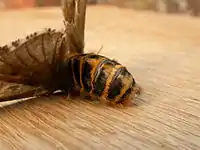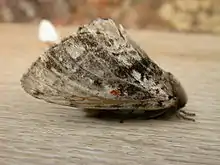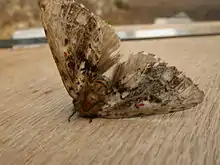Aglaosoma variegata
Aglaosoma variegata, the patterned notodontid, is a species of moth of the family Notodontidae first described by Francis Walker in 1855. It is known from the Australian states of New South Wales, Queensland and Victoria.

| Aglaosoma variegata | |
|---|---|
 | |
 | |
| Scientific classification | |
| Kingdom: | |
| Phylum: | |
| Class: | |
| Order: | |
| Family: | |
| Subfamily: | |
| Genus: | Aglaosoma |
| Species: | A. variegata |
| Binomial name | |
| Aglaosoma variegata | |
| Synonyms | |
| |
Adults have forewings with a striking pattern of cream and dark brown. The hindwings are cream with brown spots along the margin.[2]
The larvae feed on various plants, including Acacia longifolia and Banksia ericifolia. They are pale grey and hairy, with a set of brown dorsal lumps and rows of blue spots. The hairs are brown with pale tips. The head is pale brown. Pupation takes place in a cocoon in the ground litter.
References
- Australian Faunal Directory
- Herbison-Evans, Don & Crossley, Stella (12 February 2019). "Aglaosoma variegata (Walker, 1855) Patterned Notodontid". Australian Caterpillars and their Butterflies and Moths. Retrieved 31 July 2019.
This article is issued from Wikipedia. The text is licensed under Creative Commons - Attribution - Sharealike. Additional terms may apply for the media files.